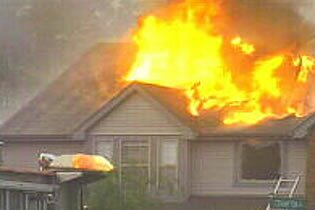| FACTS |
 |
Lightning rods will neither attract nor repel lightning. They simply provide a pre-determined path of low resistance to the ground, where a harmless discharge takes place. |
 |
A custom designed system may be concealed during construction or semi-concealed on existing buildings, thereby not interfering with the aesthetics of the architecture. Roof terminals are only 10" tall. |
 |
Will give your family peace of mind, save money for costly repairs on the building and/or appliances, and increase the value of your home. |
 |
Structural damage simulated in General Electric Laboratories showed that lightning caused metal to vaporize, wood to split, bricks & stones to burst, and concrete to shatter. |
 |
Lightning protection systems today are constructed of durable materials. Maintenance is not required unless you make changes to the structure, the roof or add a satellite dish. |
 |
Main components of lightning protection are:
| A. |
Air Terminals installed on roof ridges, dormer, chimneys, ventilators and other structures. |
| B. |
Main Conductors are cables that interconnect the air terminals to grounds. |
| C. |
Ground Terminations are typically copper or copper-clad rods driven into the earth approximately 2'-5' from the foundation and a minimum of 10' in depth. |
| D. |
Bonding Connections are made to equalize the potential between grounded metal objects. |
| E. |
Lightning Arresters protect wiring from lightning induced damage. |
| F. |
Surge Suppressors may be added to further protect valuable electronic equipment. |

|
FICTION |
 |
A grounded home is protected against lightning strikes. Grounding only protects electrical safety |
 |
Our antenna is grounded. This is not meant to handle a lightning strike and allows dangerous current to enter the home. |
 |
The trees surrounding our home are higher and will protect our home from strikes. Many times trees are struck and side flash to the house. |
 |
Installing protection is a great "do it yourself" project. Your first clue that this is a bad idea should be that there aren't any Saturday morning classes at your local hardware store on this subject. A proper system takes into account your home's design, construction, electrical components, soil conditions and more. The tiniest spark from an improperly installed system could cause fire, death or injury. |
 |
Lightning never strikes the same place twice. Since lightning results from a cloud-to-ground attraction, it only makes sense that the conditions causing the first strike, could produce another one. |
 |
Surge arrestors and suppressors are already protecting my home. Surge suppressors are important components of a complete system, but can do nothing to protect a structure against direct lightning strikes. Arrestors must be installed in conjunction with a lightning protection system. |
 |
Insurance will cover damages, so I'll take my chances. This is generally true for an initial occurrence; however, second and third claims may be denied. Non-renewal of policies has occurred after a lightning claim has been entered. |
 |
I live in a low-lying area; I'm safe from lightning. False, all elevations are susceptible to strikes. |
